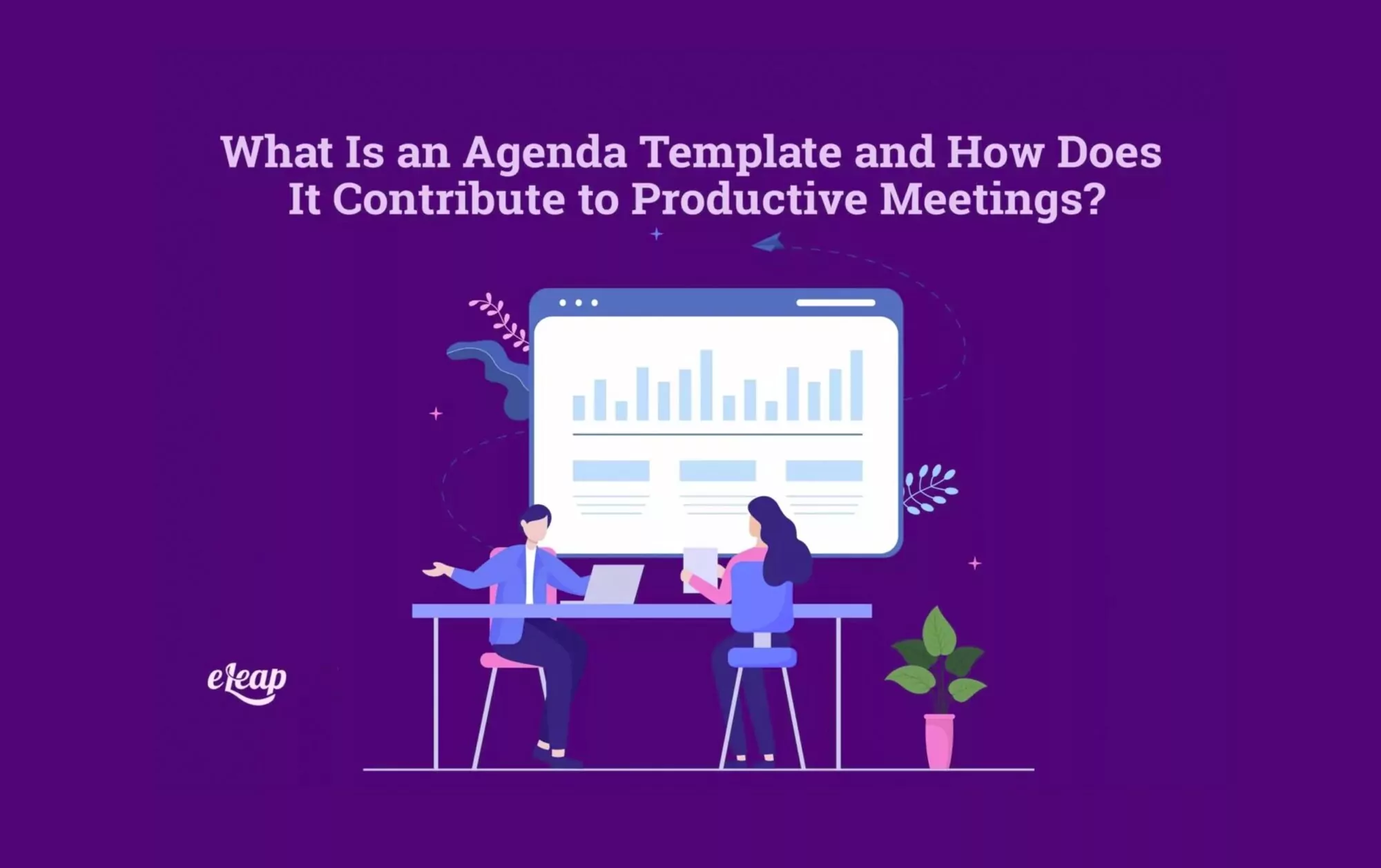What Is an Agenda Template and How Does It Contribute to Productive Meetings?

Work meetings – whether you hate to love them or love to hate them, sticking to an agenda template can help keep the meetings focused and moving along so that they no longer feel like a waste of time. Many employees have likely been subjected to a poorly managed meeting in which there was no guidance or direction. The discussion is poorly managed and frequently veers off track, sometimes into the non-work-related subject matter. As a result, the meeting runs outside of its designated time slot, cutting into employee work time and delaying other meetings set to take place in the same space which creates a major productivity block for all the employees affected. Team members eventually leave the meeting feeling frustrated and as though the meeting could have been an email. Using an agenda template could have aided in the avoidance of all those issues.

What Is a Meeting Agenda Template?
An agenda template is a framework used to coordinate the overall purpose of a meeting so that it runs smoothly and effectively. It should include all talking points, performance tasks, activities, and topics that are relevant to the meeting’s purpose, in addition to which team member is responsible for each topic. An agenda template Is like a guided itinerary for the meeting to follow and should be given to all participating employees in advance of the meeting itself.
The Importance of Using an Agenda Template for Meetings
Meetings are usually scheduled during the normal business hours of an organization. Consequently, the meeting time is typically cutting into valuable productivity time for any employees expected to participate. For this reason, it is imperative that the meeting is a valuable use of company time.
One way to accomplish this is to utilize an agenda template to build and define the purpose of the meeting. It increases the likelihood that the meeting will be helpful and effective. Here are a few reasons why using an agenda template is extremely beneficial to workplace meetings.
-
Defining a Meeting’s Purpose
An agenda template is used to clarify any objectives that need to be met during the meeting so that the time is spent productively. Sending this information out to participants ahead of time means that employees will show up to the meeting already prepared to discuss the designated topics and be on the same page as to why the meeting is being held in the first place.
-
Increases Team Input During the Discussion
When employees can show up prepared for the meeting, they are more likely to contribute to the discussion that takes place because they’ve had some time to ruminate on the topics prioritized on the agenda template. This will increase the variety of questions, ideas, and other valuable input that is shared during the meeting.
-
Keeps the Meeting on Task
Nothing is worse than failing to get through all the important topics within the scheduled time of the meeting. Employees eventually need to get back to work and other meetings could be scheduled to take place in the same space. The last thing you want is to schedule an additional meeting time to finish discussing the necessary topics and take even more time away from employees than what is necessary.
In addition to outlining the exact topics that are to be discussed during a meeting to create a clearly defined outline to follow, an agenda template can also indicate how much meeting time is allotted to each topic. This helps to make sure that each topic has its moment for discussion and that the meeting does not run over the allotted time.
-
Creates a Backup of Information
Having a completed agenda template for meetings is another way for participants to be able to check back and gain more clarity on topics that were discussed. When the agenda template has been updated with any decisions made during the meeting, it makes an even more thorough point of reference.
-
Defines Team Member Responsibilities
In addition to general meeting notes, agenda templates should define which team members are responsible for which topics, as well as who made any decisions during the meeting. The agenda template should also define with whom expectations lie going forward.
Who Oversees Creating an Agenda Template?
We’ve gone over reasons why a meeting agenda template is beneficial, but who has the responsibility of writing it out? First and foremost, the organizer of the meeting should be the one designing the template, but it is the responsibility of all team members to contribute to the discussion topics. The manager should be left to choose all discussion topics only on rare occasions, but team meetings are more beneficial to the entire team when everyone is involved and can bring up concerns.
What Should Be Included in an Agenda Template?
It’s extremely important for agenda templates to comprehensively reflect the needs of the intended meeting. These templates should have a clear definition for the main theme of the meeting, in addition to any talking points listed to be discussed. Any applicable support documents should also be attached to the agenda template so that they are available to each participating employee as needed. The agenda template should include space for notes on any decisions that are made regarding the discussion list, as well as any solutions or action items that were decided upon during the meeting.
How to Put an Agenda Template into Action
Now that the agenda template has been written, it’s time to put it to the test with its first meeting. These are some actionable items that pertain to using the agenda template you’ve written for the meeting.
-
Make Sure the Template Includes Headings
Using simple headings on the agenda template allows the same template to be used for multiple different meetings. If you can avoid having to rewrite the agenda template each time a meeting is on the calendar, you’ll save a lot of time.
-
Encourage Teammates to Contribute
The agenda template should be sent out to participants ahead of the meeting so that they have enough time to contribute anything they feel necessary for the meeting’s discussion. Make sure they’re aware they have permission to do so and encourage their input of any questions, concerns, or suggestions.
-
Check Off Topics as the Meeting Goes On
Whether you have a paper copy of the meeting agenda template or are working with an electronic copy, follow along with the topic itinerary by checking off topics and making notes as you go. This will help you stay focused on the current topic and help you look directly at the next item up for discussion.
-
Keep Thorough Notes
Take detailed notes on any key decisions reached during the meeting or any pivotal thoughts that were brought up. Also, make note of any action steps discussed to keep the team accountable for any shifting goals, as well as if certain action steps were assigned to certain people to keep track of who is responsible for which parts of the project.
-
Ensure Meeting Notes are Shared
In addition to providing a point of reference to those who were able to attend the meeting in person, the meeting notes should be shared with anyone unable to join the meeting during the designated time. Whether there are other work obligations or personal issues, sometimes things come up and people are unable to attend meetings. Making sure good notes are taken and making sure those notes are provided to anyone who may have missed out can make sure the entire team stays informed of ongoing developments relevant to the meeting.
Meeting Agenda Templates are Not Concrete Documents
When you write an agenda template to be used for work meetings, keep an open mind when it comes to its rigidity. The template should be a flexible document that is subject to change as needed. It may take a little troubleshooting to dial in the perfect agenda template for routine team meetings, and it might never be 100 percent perfect, but your team will eventually learn what works best for them as far as meeting notes and template elements to make every meeting as productive and organized as possible.
In Summary
Meeting agenda templates are great tools to use for organization and record keeping within meetings, whether it’s a weekly team check-in or a monthly project brainstorming session. An agenda template helps to plan a more organized and productive meaning by clearly tracking discussion topics, decisions, team member responsibilities, and more. These templates are certainly valuable tools that have a place in any organization.
The eLeaP continuous performance management system provides organizations with powerful options to attract and retain high caliber team members.